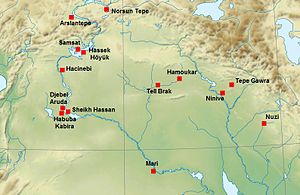Tepe Gaura
(ar) تيبي غاورا  | ||||
| ||||
| Tipus | Tel i jaciment arqueològic  | |||
|---|---|---|---|---|
| Localització | ||||
| Entitat territorial administrativa | Governació de Nínive (Iraq)  | |||
| ||||
Tepe Gawra o Tepe Gaura és un jaciment arqueològic de Mesopotàmia al nord-oest de l'Iraq prop de l'antiga Nínive a 3 km de Khorsabad i 25 km al nord-est de Mossul, a la governació de Ninive. S'han excavat 16 nivells d'ocupació que van entre vers el 5000 aC i el 1500 aC. Inclou el temple decorat amb pilastres i esquerdes més antic dels coneguts. El període de Gauwra o cultura de Gaura (3500 aC - 2900 aC) porta el nom d'aquest lloc. El nom Gaura o Gawra deriva del kurd i vol dir "munt gran".
Arqueologia
El munt té 120 metres de diàmetre i 22 metres d'altura. Fpu explorat per Austen Layard abans de 1850.[1] i després excavat el 1927, 1931 i 1932 (8 mesos en total) per arqueolegs americans [2] [3] [4] [5] [6] [7]
Cronologia relativa
Referències
- ↑ A. H. Layard, Nineveh and Its Remains, John Murray, 1849
- ↑ E. A. Speiser, Excavations at Tepe Gawra 1, University of Pennsylvania Museum of Archaeology and Anthropology, 1935.
- ↑ Arthur Tobler,. Excavations at Tepe Gawra 2, University of Pennsylvania Museum of Archaeology and Anthropology, 1950
- ↑ E. A. Speiser, New Discoveries at Tepe Gawra and Khafaje, American Journal of Archaeology, vol. 41, no. 2, pp. 190-193, 1937
- ↑ The Expedition to Tell Billa and Tepe Gawra, Bulletin of the University Museum, University of Pennsylvania, vol. 3(2), pp. 59-66, 1931
- ↑ Developments at Tell Billa and Tepe Gawra, Bulletin of the University Museum, University of Pennsylvania, vol. 3(3/4), pp. 94-95, 1932
- ↑ Excavations at Tell Billa and Tepe Gawra, Bulletin of the University Museum, University of Pennsylvania, vol. 3(5), pp. 126-130, 1932
- ↑ Liverani, Mario. The Ancient Near East: History, Society and Economy (en anglès). Routledge, 2013, p. 13, Taula 1.1 "Chronology of the Ancient Near East". ISBN 9781134750917.
- ↑ 9,0 9,1 Shukurov, Anvar; Sarson, Graeme R.; Gangal, Kavita «The Near-Eastern Roots of the Neolithic in South Asia» (en anglès). PLOS One, 9 (5), 07-05-2014, pàg. e95714. Bibcode: 2014PLoSO...995714G. DOI: 10.1371/journal.pone.0095714. ISSN: 1932-6203. PMC: 4012948. PMID: 24806472.
- ↑ Bar-Yosef, Ofer; Arpin, Trina; Pan, Yan; Cohen, David; et al. «Early Pottery at 20,000 Years Ago in Xianrendong Cave, China» (en anglès). Science, 336(6089), 29-06-2012, pàg. 1696-1700. Bibcode: 2012Sci...336.1696W. DOI: 10.1126/science.1218643. ISSN: 0036-8075. PMID: 22745428.
- ↑ Thorpe, I. J.. The Origins of Agriculture in Europe (en anglès). Routledge, 2003, p. 14. ISBN 9781134620104.
- ↑ Price, T. Douglas. Europe's First Farmers (en anglès). Cambridge University Press, 2000, p. 3. ISBN 9780521665728.
- ↑ Stiebing, William H. (Jr); Helft, Susan N. Ancient Near Eastern History and Culture (en anglès). Routledge, 2017, p. 25. ISBN 9781134880836.
Bibliografia
- Mitchell S. Rothman, Tepe Gawra: The Evolution of a Small, Prehistoric Center in Northern Iraq, University Museum Publications, 2001, ISBN 0924171898
- P. Butterlin (éd.), A propos de Tepe Gawra, le monde proto-urbain de Mésopotamie - About Tepe Gawra: a proto-urban world in Mesopotamia, Brepols Publishers, 2009, ISBN 978-2-503-53002-4
- T. E. Davidson and Hugh McKerrell, The Neutron Activation Analysis of Halaf and 'Ubaid Pottery from Tell Arpachiyah and Tepe Gawra, Iraq, vol. 42, no. 2, pp. 155–167, 1980
- E. A. Speiser, The Bearing of the Excavations at Tell Billa and at Tepe Gawra upon the Ethnic Problems of Ancient Mesopotamia, American Journal of Archaeology, vol. XXXVI, pp. 29–35, 1932
Enllaços externs
- Excavatinf Tepe Gawra in the archives of the University of Pennsylvania Museum Arxivat 2020-06-21 a Wayback Machine.
- Fotos de Gaura del Oriental Institute Arxivat 2012-10-07 a Wayback Machine.



